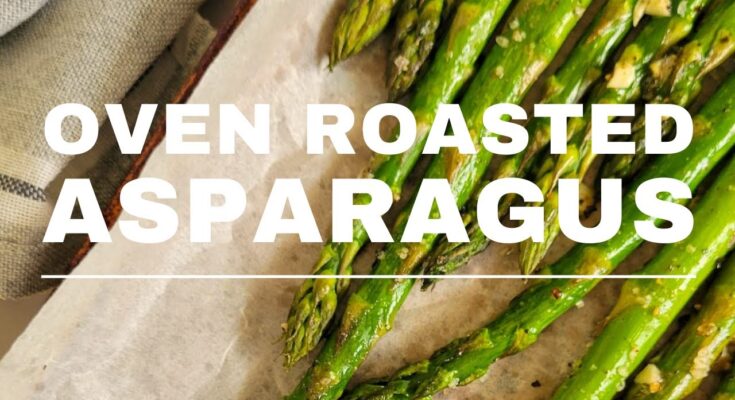Oven Roasted Asparagus Recipe: Oven-roasted asparagus is a simple yet elegant dish that elevates any meal. It’s quick to prepare, healthy, and absolutely delicious. The roasting process brings out the natural sweetness of asparagus while giving it a slight caramelized crunch. Whether you’re a seasoned home chef or a beginner in the kitchen, this recipe is foolproof and guarantees flavorful results every time.
Benefits of Including Asparagus in Your Diet
Asparagus is a nutrient powerhouse. Packed with vitamins A, C, E, and K, it boosts your immune system, improves skin health, and supports bone strength. Additionally, asparagus is high in antioxidants and low in calories, making it perfect for anyone looking to maintain a balanced diet. With its natural diuretic properties, it’s also great for detoxifying the body.
Ingredients Required
Essential Ingredients
For this recipe, you’ll need just a handful of basic ingredients:
- 1 bunch of fresh asparagus
- 2 tablespoons of olive oil
- 1 teaspoon of kosher salt
- 1/2 teaspoon of freshly ground black pepper
Optional Add-ons for Flavor Enhancement
While the classic version is fantastic, you can customize it with these optional ingredients:
- 2 cloves of minced garlic
- Zest and juice of 1 lemon
- Grated Parmesan cheese
- Crushed red pepper flakes for a spicy kick
Preparation Steps
Selecting Fresh Asparagus
Start by choosing the freshest asparagus available. Look for bright green stalks with firm tips. Avoid any that appear wilted, mushy, or have an off-color. Thinner stalks tend to be more tender and cook faster, while thicker ones offer a meatier texture.
Washing and Trimming Asparagus
Rinse the asparagus thoroughly under cold running water to remove any dirt or debris. Pat them dry with a clean kitchen towel. Trim the woody ends by snapping them off naturally—this ensures you’re left with the tender, edible portion of the stalk.
Preparing Your Baking Sheet
Line a baking sheet with parchment paper or aluminum foil for easy cleanup. Lightly grease the sheet with olive oil to prevent sticking. Ensure the sheet is large enough to allow the asparagus to lay in a single layer for even roasting.
Roasting Instructions
Preheating the Oven
Preheat your oven to 400°F (200°C). Proper preheating ensures consistent cooking and helps achieve that crispy texture.
Seasoning the Asparagus
Place the asparagus on the prepared baking sheet. Drizzle with olive oil, sprinkle with salt and pepper, and toss to coat evenly. For added flavor, include your optional add-ons, such as garlic or lemon zest.
Arranging on the Baking Sheet
Spread the asparagus out so no pieces overlap. Crowding the pan can result in uneven cooking and steaming rather than roasting.
Cooking Time and Temperature
Roast the asparagus in the preheated oven for 12-15 minutes. Thinner stalks may cook faster, so start checking at the 10-minute mark. The asparagus is done when it’s tender yet slightly crisp on the outside, with a vibrant green color.
Serving Suggestions
Pairing with Other Dishes
Roasted asparagus pairs beautifully with grilled chicken, salmon, or steak. It’s also an excellent side dish for pasta or risotto, adding a touch of freshness and crunch to your meal.
Garnishing Ideas
Before serving, sprinkle grated Parmesan or a squeeze of lemon juice over the asparagus for an added burst of flavor. Fresh herbs like parsley or dill can also enhance the dish’s presentation and taste.
Tips for Perfectly Roasted Asparagus
Avoiding Overcooking
The key to perfectly roasted asparagus lies in its texture. Overcooking can result in limp, soggy stalks that lose their vibrant color and fresh taste. Stick to the suggested roasting time of 12-15 minutes and keep an eye on the asparagus during the last few minutes. It should be tender with a slight crunch, not mushy.
Experimenting with Spices and Herbs
Don’t be afraid to get creative with your seasoning! Beyond salt and pepper, try adding spices like smoked paprika, cumin, or even curry powder for a unique twist. Herbs like thyme, rosemary, or oregano can add an earthy depth of flavor, making this simple dish feel gourmet.
Variations of Roasted Asparagus
Parmesan Crusted Asparagus
For a cheesy upgrade, sprinkle grated Parmesan cheese over the asparagus before roasting. The cheese will melt and form a crispy crust, adding a rich and nutty flavor to the dish. For even more indulgence, mix the Parmesan with breadcrumbs for a crunchy topping.
Garlic and Lemon Asparagus
This variation is a classic. Toss the asparagus with minced garlic and a splash of fresh lemon juice before roasting. The garlic infuses the asparagus with a savory aroma, while the lemon adds a bright and zesty contrast.
Spicy Roasted Asparagus
If you enjoy a bit of heat, sprinkle crushed red pepper flakes over the asparagus before popping it in the oven. You can also add a drizzle of hot sauce or a pinch of cayenne pepper for an extra spicy kick.
Storing and Reheating Tips
Storing Leftover Asparagus
If you have leftovers, let the roasted asparagus cool completely before storing it in an airtight container. It will stay fresh in the refrigerator for up to 3 days. Avoid leaving it at room temperature for extended periods to maintain its quality.
Reheating Techniques
To reheat, place the asparagus on a baking sheet and warm it in a 350°F (175°C) oven for 5-7 minutes. Alternatively, you can reheat it in a skillet over medium heat with a drizzle of olive oil for a quick refresh. Avoid microwaving, as it may cause the asparagus to become soggy.
Common Mistakes to Avoid
Overcrowding the Baking Sheet
One of the most common mistakes is piling the asparagus too close together on the baking sheet. When the stalks overlap, they steam instead of roast, resulting in a less crispy texture. Always arrange them in a single layer with enough space between each piece.
Using Too Much Oil
While olive oil enhances flavor and aids in roasting, using too much can leave the asparagus greasy and heavy. Stick to 1-2 tablespoons, ensuring the stalks are lightly coated without being drenched.
Skipping the Preheating Step
Skipping the preheating step can lead to uneven cooking. A properly preheated oven ensures the asparagus cooks at the right temperature from the start, resulting in perfectly roasted stalks with a tender-crisp texture.
FAQs about Oven Roasted Asparagus Recipe
1. What temperature should I use to roast asparagus in the oven?
For optimal results, roast asparagus in an oven preheated to 400 degrees Fahrenheit (200 degrees Celsius). This temperature allows the asparagus to cook thoroughly while achieving a slight crispiness.
2. How long does it take to roast asparagus?
Roasting asparagus typically takes between 12 to 15 minutes. The exact timing can depend on the thickness of the spears; thinner spears may need slightly less time, whereas thicker ones might need a few more minutes.
3. Should I peel asparagus before roasting?
Peeling is not necessary for most asparagus, especially if the spears are fresh and tender. However, for very thick spears, peeling the bottom half can help ensure even cooking and remove any tough, fibrous skin.
4. How can I season roasted asparagus?
Asparagus pairs well with a variety of seasonings. Simple options include salt, pepper, and a drizzle of olive oil. For more flavor, consider adding minced garlic, lemon zest, grated Parmesan cheese, or a sprinkle of crushed red pepper flakes.
5. Can I make roasted asparagus ahead of time?
While asparagus is best enjoyed fresh from the oven, you can roast it ahead of time and reheat it. To maintain its texture, reheat it in the oven at 350 degrees Fahrenheit for about 5 minutes or until it’s heated through.
6. Is roasted asparagus healthy?
Yes, roasted asparagus is a healthy side dish. It’s low in calories, rich in fiber, and provides a good source of vitamins A, C, and E, as well as folate and iron.
7. What should I do with leftover roasted asparagus?
Leftover roasted asparagus can be chopped and added to salads, omelets, or pasta dishes. It can also be enjoyed cold as a snack or appetizer with dip.
Conclusion
Oven-roasted asparagus is a versatile, delicious, and healthy side dish that’s incredibly easy to make. Whether you’re hosting a dinner party or preparing a simple weeknight meal, this recipe is sure to impress. With endless customization options, you can adapt it to suit any palate or occasion. Now that you’ve got all the tips and tricks, it’s time to fire up your oven and give this recipe a try!



